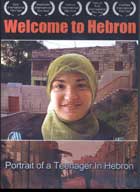
Welcome to Hebron: An Intimate Portrait of a Teenager in Hebron 2010
Distributed by Rhizome Intermedia,
324 S. Beverly Drive, PMB 437, Beverly Hills, CA 90212 310-839-1500
Produced by Terje Carlsson
Directed by Terje Carlsson
DVD , color, 55 min.
Jr. High - General Adult
Human Rights, Palestine, Arab-Israeli Conflict
Date Entered: 01/06/2014
Reviewed by Sandra Collins, Byzantine Catholic Seminary Library, Pittsburgh, PAThis film offers a glimpse of the reality of life for Palestinians living within occupied Hebron through the eyes of 17-year-old Leila Sarsour, with additional commentary by Yehuda Shaul, one of the founders of Breaking the Silence, an organization dedicated to confronting the realities of Israeli occupation for returning soldiers. Some startling numbers are offered—Hebron is home to approximately 150,000-200,000 Palestinians and between 500-600 Israeli settlers. A significant occupying Israeli military force therefore is present in Hebron in order to protect Israeli men, women and children from Palestinian violence. However, images of barbed wire, orchards and fields fenced off by the settlers to keep the Palestinians out, and rock throwing Israeli women and children begs a question posed by Shaul: is a settler worth more than a Palestinian?
Although the framing device for the film is Leila, we learn very little about her except that her mother is Romanian and her father is Palestinian but, since she was born in Romania and then moved to Palestine as a child, she is technically not a Palestinian citizen. Whether or how this might complicate an already chaotic situation is never really explored. Rather, Leila is the impetus for viewing this complex, violent situation from her youthful perspective, one tinged with realism as well as a healthy dose of hope for future education and travel. Ultimately, though, she is one of the many children we see in this film including, most disturbingly, the numerous images of violent little Israeli boys and girls hurling stones, shouting denigrating epithets and kicking at Palestinians throughout this film. Concludes Shaul, this ethnic hate and violence is not instinctive but rather, is part of the education that settlers’ children receive in this land.
One criticism of this film is its painting with too broad of a brush: the assumption here is that all Palestinians are Muslims. In fact, 8% of the West Bank is made up of Christians of Palestinian descent but it’s not clear whether or not the settlers also view these Christians with the same distrust as they do the Muslims. Furthermore, there are no images of Palestinians retaliating or reasserting their prerogatives suggesting that they play no role in this toxic situation. Those Palestinians within Hebron appear as lambs before the vitriolic hatred of Hebron’s Jewish settlers; the only rationale given refers to the Jews’ biblical birthright to this land.
While offering a tender and humanizing picture of Palestinians within Hebron, the film’s sympathies clearly lie with those (Israelis as well as others) who are questioning Israel’s right to force Palestinians from the West Bank at all cost. While it seems unlikely that such a work will change diametrically opposed minds, it has the potential to create the space for dialogue where there are those who are able to engage both sides of this caustic, ferocious divide.